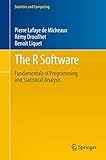The R software : fundamentals of programming and statistical analysis / Pierre Lafaye de Micheaux
Material type: TextSeries: Statistics and computingPublisher: New York : Springer, [2013]Copyright date: 2013Description: xxxvii, 628p.:ill.:24cm illustrations (some color) ; 24 cmContent type:
TextSeries: Statistics and computingPublisher: New York : Springer, [2013]Copyright date: 2013Description: xxxvii, 628p.:ill.:24cm illustrations (some color) ; 24 cmContent type: - text
- still image
- unmediated
- volume
- 9781461490197
- 1461490197
- R (Computer program language)
- Mathematical statistics -- Computer programs
- Mathematical statistics -- Data processing
- Méthodes statistiques
- Langages de programmation
- Traitement des données
- Analyse mathématique
- Statistique
- Mathématiques
- Manuels
- Mathematical statistics -- Computer programs
- Mathematical statistics -- Data processing
- R (Computer program language)
- Matematisk statistik
- 519.5 LAF 23
- QA276.45.R3 L34 2013
| Item type | Current library | Collection | Call number | Status | Notes | Date due | Barcode | |
|---|---|---|---|---|---|---|---|---|
| Reference Book | VIT-AP Reference | Reference | 519.5 LAF (Browse shelf(Opens below)) | Not For Loan | MATH | 023866 |
Includes bibliographical references and indexes.
Part I. Preliminaries. -- 1. Introducing R -- 2. A Few Data Sets and Research Questions. -- -- Part II. The bases of R. -- 3. Basic Concepts and Data Organisation -- 4. Importing, Exporting and Producing Data -- 5. Data Manipulation, Functions -- 6. R and Its Documentation -- 7. Drawing Curves and Plots -- 8. Programming in R -- 9. Managing Sessions. -- -- Part III. Elementary mathematics and statistics. -- 10. Basic Mathematics: Matrix Operations, Integration, Optimization -- 11. Descriptive Statistics -- 12. A Better Understanding of Random Variables, Distributions and Simulations Using R Specificities -- 13. Confidence Intervals and Hypothesis Testing -- 14. Simple and Multiple Linear Regression -- 15. Elementary Analysis of Variance -- Appendix: Installing R and R Packages.
"The contents of The R Software are presented so as to be both comprehensive and easy for the reader to use. Besides its application as a self-learning text, this book can support lectures on R at any level from beginner to advanced. This book can serve as a textbook on R for beginners as well as more advanced users, working on Windows, MacOs or Linux OSes. The first part of the book deals with the heart of the R language and its fundamental concepts, including data organization, import and export, various manipulations, documentation, plots, programming and maintenance. The last chapter in this part deals with oriented object programming as well as interfacing R with C/C++ or Fortran, and contains a section on debugging techniques. This is followed by the second part of the book, which provides detailed explanations on how to perform many standard statistical analyses, mainly in the Biostatistics field. Topics from mathematical and statistical settings that are included are matrix operations, integration, optimization, descriptive statistics, simulations, confidence intervals and hypothesis testing, simple and multiple linear regression, and analysis of variance. Each statistical chapter in the second part relies on one or more real biomedical data sets, kindly made available by the Bordeaux School of Public Health and described at the beginning of the book. Each chapter ends with an assessment section: memorandum of most important terms, followed by a section of theoretical exercises (to be done on paper), which can be used as questions for a test. Moreover, worksheets enable the reader to check his new abilities in R. Solutions to all exercises and worksheets are included in this book"--Back cover.
There are no comments on this title.

